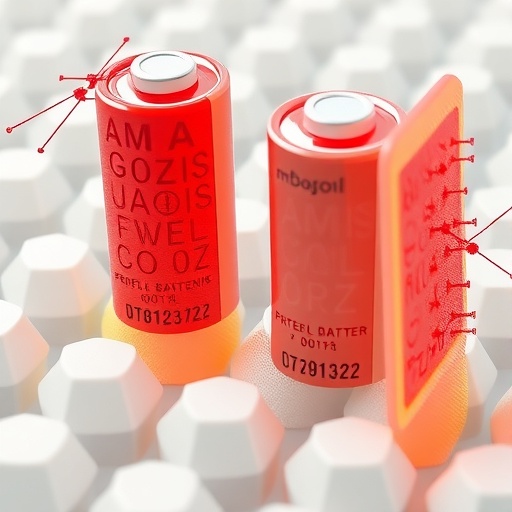In the relentless pursuit of safer, more sustainable energy storage solutions, zinc-based batteries have emerged as a formidable contender against the dominant lithium-ion systems. Celebrated for their lower costs, enhanced safety profiles, and environmental friendliness, zinc batteries have captivated global research efforts. Yet, a persistent obstacle has hindered their widespread adoption: the instability at the crucial interface between the zinc anode and the electrolyte. This delicate boundary tends to degrade under operational stresses, fostering dendrite formation—a detrimental growth of zinc structures that provoke short circuits and premature capacity fade.
Addressing this age-old challenge, a team of engineers and materials scientists at South China University of Technology (SCUT) have pioneered a cutting-edge manufacturing technique by integrating digital light processing (DLP) 3D printing with gel-polymer electrolyte (GPE) design. DLP is a state-of-the-art additive manufacturing process wherein ultraviolet light selectively cures polymer resins layer by layer, enabling intricate three-dimensional architectures with micron-scale precision. This breakthrough allows for unprecedented control over electrolyte microstructures, directly tuning the mechanical stresses at the zinc anode interface.
Their findings, recently published in the International Journal of Extreme Manufacturing, showcase how manipulating the polymerization degree, pore size distribution, and layer thickness via DLP empowers researchers to program interfacial stress fields within these quasi-solid-state electrolytes. By modulating these parameters with micron accuracy, the researchers demonstrated remarkable suppression of uneven zinc deposition, fostering stable, dendrite-free cycling even under harsh temperature fluctuations from −10 °C to 60 °C.
Mechanical stresses within batteries, traditionally regarded as undesirable byproducts of electrochemical reactions, have long posed significant challenges in battery design. Conventional gel electrolytes with irregular, stochastic pore structures yield unpredictable stress distributions, accelerating interface deformation and failure. However, SCUT investigators flipped this paradigm on its head by embracing stress as an engineerable material attribute rather than a liability. Through DLP-facilitated control over electrolyte microarchitecture, they effectively designed stress to be uniform and balanced, optimizing ionic pathways while preserving intimate contact between the zinc anode and the GPE.
The SCUT team employed multiphase-field simulations combined with both in situ and ex situ characterization techniques to elucidate zinc-ion transport and deposition dynamics within their designer electrolytes. They observed that even minute variations in electrolyte thickness or porosity introduced localized stress imbalances, triggering non-uniform zinc plating and subsequent dendrite nucleation. By leveraging the exquisite precision of DLP printing, these microstructural features were finely tuned, ensuring homogeneous zinc ion flux and uniform deposition layers that sustain long-term battery integrity.
Performance metrics of the batteries crafted using this method are nothing short of impressive. Symmetrical zinc cells cycled stably for over 2,000 hours without significant degradation, while full cells retained over 91% of their initial capacity after 8,000 charge-discharge cycles. Such longevity under wide-ranging thermal conditions signifies a major leap toward practical zinc-ion battery deployment in real-world applications where reliability and safety are paramount.
Beyond their immediate achievements, SCUT’s work heralds a transformative approach to electrochemical device engineering. The ability to digitally manufacture electrolytes with tailored stress landscapes paves the way for next-generation energy storage technologies, including flexible batteries and fuel cells, which demand mechanical robustness alongside electrochemical performance. This capability also opens new avenues for adaptive design, where evolving software algorithms could optimize electrolyte architectures in silico before physical fabrication.
Looking forward, the SCUT group intends to push the boundaries further by exploring multilayered and more complex 3D electrolyte constructs. Coupling advanced design algorithms with adaptive photopolymerization strategies may unlock even greater control over mechanical and ionic properties at critical electrochemical interfaces. Such innovations hold promise for batteries that are not only safer and longer-lasting but also highly predictable in performance, transforming the paradigm of electrochemical energy storage into a realm where mechanical stress is no longer a threat but a deliberately engineered asset.
Professor Wei Yuan, the study’s lead author, encapsulates the significance: “This marks a fundamental shift in how we perceive and manage mechanical stress in battery systems. By treating stress as a designable feature instead of an uncontrollable weakness, we unlock pathways to safer, more durable batteries engineered at the microscopic level.” With this pioneering integration of digital light 3D printing and polymer chemistry, the dream of robust, ultralong-life zinc batteries is closer to reality than ever before.
As global demand surges for greener and more resilient energy storage, innovations like these underscore the pivotal role of interdisciplinary research at the intersection of materials science, manufacturing, and electrochemistry. The SCUT team’s advances envisage a future where additive manufacturing transforms battery interfaces into meticulously engineered systems, fostering sustainable technologies that meet the rigorous demands of modern energy infrastructures.
Subject of Research: Zinc-ion battery anode-electrolyte interface stabilization via digitally manufactured gel polymer electrolytes
Article Title: Precise regulation of zinc-anode interface stresses by digital-light-processed gel polymer electrolytes for ultralong-life zinc batteries
News Publication Date: 29-Sep-2025
Web References:
Image Credits: By Yangfan Zhou, Wei Yuan, Xuyang Wu, Qing Liu, Xiaoqing Zhang, Tengjia Gao, Pei Wang, Chun Li, Guanhua Zhang, Yubin Zeng and Yong Tang.
Keywords: Batteries, Energy storage, Zinc, Gel polymer electrolytes, Digital light processing, 3D printing, Additive manufacturing, Anodes, Electrodes, Mechanical stress, Ionic conductivity, Materials engineering




